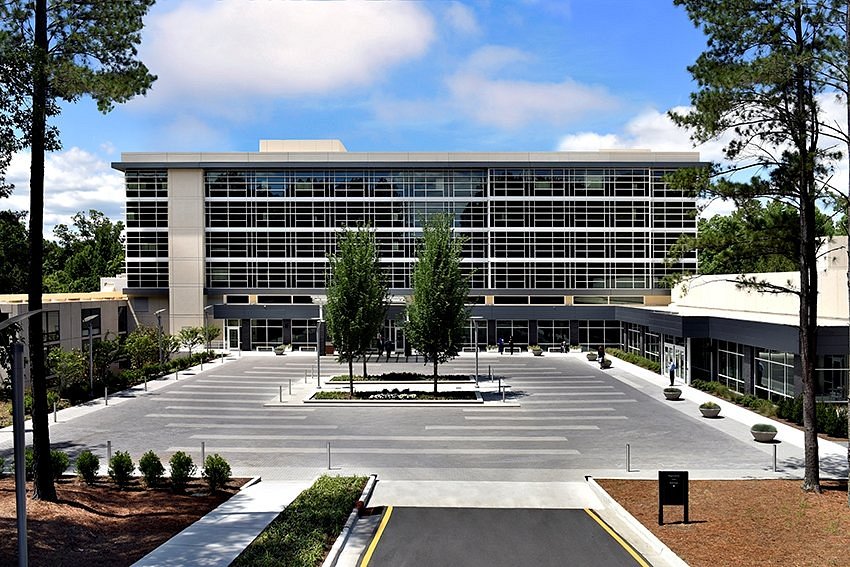University of Notre Dame
How Notre Dame Used the Panopto + Zoom Integration to Streamline and Elevate Virtual Learning

Achievements
150 Fully-Enabled Lecture Capture Spaces
Fully Remote-Controlled Cameras for Lectures
Implemented Rapid Shift of Unified Technology Systems
Intro
When the COVID-19 pandemic began in March 2020, the Office of Information Technologies (OIT), Notre Dame Learning, and ND Studios Teaching & Learning Technologies (TLT) teams at the University of Notre Dame had to initiate a rapid shift and integrate its disparate technology systems and tools to enable virtual learning campus-wide.
Notre Dame had been a customer of both Zoom and Panopto for several years, using each system independently as needed. Before the pandemic, the university used Panopto for scheduled classroom recordings and lecture capture within its learning management system (LMS), and it used Zoom as a communications platform for video conferencing. Upon learning of the Panopto + Zoom integration, Office of Information Technologies staff decided to integrate and scale the two systems for campus use.
As students returned to campus for the Fall 2020 semester, the university offered dual-mode teaching and learning. To elevate that experience, integrated technology systems were essential. Leveraging Panopto and Zoom together provided key elements that supported the University’s concept of the “classroom as an ecosystem.” Usage of both Panopto and Zoom skyrocketed.
Moving into the 2021-2022 academic year, Notre Dame invited students back to in-person classes, and the Panopto + Zoom integration continued to make an impact. As a result of the integration, the University has now successfully streamlined enhanced face-to-face learning and given professors new tools to improve their learning outcomes. Even with a shift in the mode of teaching and learning, the students and faculty supported this new educational experience.
Preserving the Classroom as an Ecosystem
With its commitment to community and a human-centered approach, the ND Studios TLT team worked toward creating an interconnected ecosystem within each classroom. Each part of the ecosystem works together and supports the other. “The problem-solving that happened that summer [2020] was around enabling that ecosystem for our faculty and students,” says Tom Marentette, IT Solutions Architect and Streaming Program Manager at Notre Dame. “And that led us to focus on ease-of-use, consistency, replicability, and scale.”
To preserve the classroom ecosystem, the Notre Dame IT team needed equipment and systems that would work together seamlessly, allowing instructors and students to remain focused on why they were there – to teach and to learn – despite the circumstances of the time. Additionally, all class recordings must be accessible in the university’s LMS.
“Our Audio Video Technologies (AVT) team, in consultation with the TLT team, ND Learning, and IT architecture colleagues, responded to the urgent task of planning, designing, ordering, and implementing AV systems to enable real-time participation between remote students and their instructors and classmates in the physical classroom,” says Dan Skendzel, Executive Director, ND Studios and Teaching and Learning Technologies at Notre Dame. “The Zoom + Panopto integration was a critical element that facilitated the real-time interaction and the asynchronous access to the instructional material in our LMS.”
The university also knew it was crucial to offer a consistent experience. “We wanted everybody to have the same experience for recording, the same expectations for the control system, and the same playback experience,” says Charles Barbour, Educational Technologist and Panopto administrator at Notre Dame. “[The consistent set-up] allowed us to focus on having an equitable experience for everyone.”
Consistency started with Notre Dame’s physical classroom set-up, which reflects seven tiers of classroom standards. When social distancing was necessary, ballrooms and other large areas were converted into classrooms with the same technology. “All of those rooms still had the same capabilities and standards in place,” says Barbour. “While the classroom might have looked different, the experience was the same.”
Each classroom space was upgraded to offer an identical set-up:
- Full lecture capture expanded from 15-20 classrooms to more than 150 spaces
- New microphones and audio processors
- Pan, tilt, and zoom cameras can be controlled remotely. They support podiums, stages, tables, chalkboards, whiteboards, student-facing views, and more.
“We were fortunate that we were a little bit ahead of the curve,” says Marentette. While Notre Dame did experience some supply chain issues and backlog of items, the installation and set-up ultimately supported a seamless Panopto + Zoom integration.
With this set-up, all faculty members were trained on how to start and record a Zoom meeting with the confidence that every recording will automatically transfer to Panopto, with no sharing of links or back-end work required. All students know how to participate in Zoom and view Panopto recordings for playback. Integration with the LMS gives students and professors quick and easy access to video. This seamless system enables ease-of-use for anyone on campus, from students and faculty to administration and academic groups.
With a wide range of technical competency among faculty, consistency and standardization helps eliminate variability and reduce confusion. “It was a very straightforward and consistent experience across the board by ensuring all recordings go into Panopto,” says Barbour. The university also established a multi-tier technology support system through Help Desk services, classroom support, training, and workshops.
“The consistent playback and recording experience across set-up allowed us to focus on having an equitable experience for everyone.”
Charles Barbour, Educational Technologist and Panopto Administrator, University of Notre Dame
Zoom Programming Streamlines the User Experience
The goal of the Notre Dame IT team is to establish consistency of the user experience and ease-of-use for all instructors, from tech novices to super users. As part of this, Notre Dame’s IT developers wrote a program called Zoom Appointment Provisioner (ZAP) through Zoom APIs to pre-create a unique meeting link with security settings for each course.
This allows a professor to arrive in the classroom and simply start a Zoom meeting without having to worry about multiple control systems. The process is simple: login to the ND network, turn on the projector, open Zoom, click Record to the Cloud, and the recording happens automatically. “They didn’t have to do anything extremely unusual, and from that perspective, it was an overwhelming success,” says Barbour.
Notre Dame IT Was Ready
With the Panopto + Zoom integration in place, Notre Dame was prepared and able to pivot quickly. Even when courses returned to face-to-face learning, the integration continued to provide consistency. “That’s the position we’re really in right now,” says Marentette. “While we’re back to face-to-face, this is all about preparedness. If we have to pivot again, everything is in place. For us, it’s about being prepared for the future.”
The Panopto + Zoom integration has also enabled faculty to incorporate new and different content into their pedagogies. Educators like Meghan Sullivan, Professor of Philosophy and Director of the Notre Dame Institute for Advanced Study, have been exploring the use of video to broaden class discussion. In Fall 2020, Sullivan and a colleague in the Notre Dame Law School planned to offer a specialized seminar course on how authors help imagine future technology and the moral problems it could cause. A renowned science fiction author who resides in Seattle was set to join the South Bend, Indiana-based class a couple times in person. But with the pandemic, the inability for him to travel threatened to cancel the course altogether.
“If we hadn’t had Zoom and Panopto, and we hadn’t had the classrooms upgraded that summer, there’s no way that class could have happened,” says Sullivan. Thanks to the Panopto + Zoom integration, the author joined class remotely every week and became a full-fledged participant, giving students extensive access to an expert speaker and deepening engagement.
“When people have questions, typically you get conversations about the classroom itself and that will inevitably lead to the teaching and learning aspect,” says Steven Varela, Director of Teaching and Learning Technologies at Notre Dame. “We wanted to maximize those relationships and that collaboration.” Through this extensive support framework, the university is able to address issues of equity so all faculty have the resources they need and are never left on their own to troubleshoot.
Embracing the Power of Video Content
Many faculty members have tapped into video to enhance traditional lectures with the addition of live Zoom office hours, remote guest speakers, and other learning opportunities. Some instructors allow students to submit a video assignment as an alternative to writing a paper. Some offer “responsive education” by creating and uploading short videos to address students’ questions as they come up. “What I’ve heard overwhelmingly from both faculty and some of the students who have been able to take advantage of this is that many have become more comfortable with the creation of video content,” says Barbour.
Sullivan says that she has experimented with video assignments, Zoom breakout rooms, and asynchronous videos on specific topics. “Our students love short explainer videos, so we get great feedback on the 2- to 4-minute, well-written explainer videos that we make available to them,” she says. “I don’t know how many of them will listen to a 45-minute lecture that’s taped.”
When it comes to lecture capture, there are some key benefits, primarily that students have the opportunity to listen and process information while in class and use the video recording for playback and review. “So many students have reported to me how valuable [it is to have] the ability to go back and review the content,” says Barbour. “None of that is possible without the two systems converging and the benefits of both of those – the tremendous value of the recording and distribution provided to our students.”
“Panopto is very useful for reviewing content. If a class was held virtually, that lecture was recorded and uploaded to Panopto where students were able to access it. Let’s say I missed class because I had an interview – the whole lecture was saved somewhere I could view it, instead of having to more traditionally ask a friend for their notes.”
Looking to the Future
While Notre Dame is committed to face-to-face learning, it believes the two types of teaching – in-person and virtual – are complementary, not competing. Technology is changing the way professors teach and students learn. The integration sets Notre Dame up for success, as instructors can evolve their teaching methods to incorporate video into their in-person courses and they are prepared if they need to pivot to virtual learning in the future.
ND Studios TLT team views video as an opportunity. “We did do a couple formal surveys of faculty and students, and it’s driving our professional development forward,” says Varela. “Coming out of this pandemic with the use of Panopto and Zoom, instructors were saying they want more professional development around creating short concept-driven focused videos, rather than the hour-and-50-minute lecture capture.”
Instructors can now enhance face-to-face learning and boost student engagement with these digital tools. Moving forward, a number of faculty will continue to use Zoom for office hours, even if they don’t use it within the classroom, and they can record those Q&A conversations to make them available to the larger class.
Students want to explore the new possibilities presented by video technology. “Because [the technology is] now in place, and it’s become the new normal, we should embrace it going forward,” says Wang. “There are a lot of benefits of video conferencing that will stay for good, given how technology increases productivity in our lives…. Having the option to potentially [move to] asynchronous or live video conference is just such a powerful tool for us.”
Continually at the forefront, the ND Studios TLT team is pursuing interest in virtual reality and other cutting-edge technology for teaching and learning. And the administration has noted an explosion of demand for virtual events, including conferences, panels, and webinars, with Zoom at the core of it all.
Synchronous and asynchronous video also gives Notre Dame more ways to offer educational opportunities and fill in any gaps. With its continual focus on diversity, equity, and inclusion, the university sees video as a method for providing an equitable experience for students unable to attend class, due to illness or travel.
“The key is [exploring] how we can enhance what we’re doing face-to-face in class with these tools so that we can address issues of equity and student engagement,” says Varela. While face-to-face learning is central to the Notre Dame educational experience, the Panopto + Zoom solution enables persistence in education and an ongoing commitment to community.






